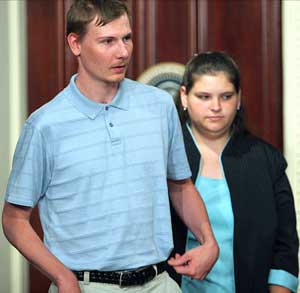


|
|
Getty Images/Karen Bleier
|
|
Randal McCloy, the sole survivor of Jan. 2 disaster at Sago, where 12 miners died on job, and his wife Anna at White House June 15. His account of disaster was just made public.
|
Federal rescue officials and company personnel on the scene, however, did not bring in equipment to pinpoint the location of the trapped workers that had been used successfully to save miners trapped underground in 2002 after the Queecreek mine disaster in Pennsylvania, as the workers trapped at Sago had hoped.
These facts became clear from testimony made public last week by the sole survivor of the Sago blast.
Randal McCloy, a 26-year-old roof bolter, was the only miner to survive the Sago disaster. Twelve others perished. McCloy was interviewed in mid-June by state and federal mine safety officials investigating the blast. After a Freedom of Information Act request by the Associated Press, the West Virginia office of the Mine Safety and Health Administration (MSHA) posted its interview with McCloy on its web site on June 28.
Eleven workers and a foreman perished in the Sago explosion, one dying from the blast itself and 11 succumbing to carbon monoxide poisoning after being trapped from the explosion underground and while waiting for rescue crews. The toll was the highest at a single mine in the state in nearly 40 years.
McCloy said that when the workers heard the explosion they were quickly enveloped in smoke and gas. They tried to exit on a mantrip, the vehicle that takes them in and out of the mine, but they soon found the vehicle’s path was blocked.
When the miners put on their self-rescuers, four of them found the devices that are supposed to provide them with oxygen in case of emergency did not work, McCloy said. He described his efforts to make the self-rescuer of fellow roof bolter Jerry Groves function. “You put air into it, you moved it, but there was nothing going on with it,” McCloy testified. “That’s what told me right there it was broken.
“I fought with it for I don’t know how long, trying to mess with that valve, blow air through it, or anything I could do, but nothing would work,” McCloy said.
Finally, the men built a makeshift barricade against the poisonous gases and smoke with plastic sheeting, the only material they could find, and shared air from the remaining self-rescuers. As they had been trained, they began beating on roof bolts with a sledgehammer, hoping to draw attention on the surface.
“I figured they’d bring that machine down and would have found us, would have drilled the hole in the right spot and would have taken us out of there,” McCloy said. “That’s what I expected. I expected to hear shots fire on the roof … and didn’t hear anything.
“We banged and banged and banged, everyone did. We had a discussion about that, about how long it was going to take,” the miner testified.
“We thought that we were going to get rescued,” McCloy said. “And as time went on, it didn’t look good.”
What the men didn’t know is that the Sago mine owners, the International Coal Group (ICG), waited two hours after the explosion before even reporting it to MSHA. It was 11 hours later that the first rescue teams entered the mine to search for the workers. They found the men 42 hours after the explosion.
McCloy was referring to seismographic equipment at the mine to detect the bangs on roof bolts. Such machinery had been used successfully in 2002 at the Queecreek mine in Pennsylvania to pinpoint the location of coal miners trapped underground after a flood. Rescuers then drilled a hole at that spot and pulled all the trapped miners on the surface. Neither the company nor the government safety officials made any attempt to get any such equipment at Sago.
During a public hearing in May on the disaster, MSHA district manager Kevin Stricklin said the agency’s seismic equipment was not needed because rescuers knew roughly where the miners were. He said it would have taken eight hours to get the machinery and set it up.
“But we know from the notes left by the men that they were alive at 4:45 p.m.,” shot back Pam Campbell, sister-in-law of Marty Bennett, one of the miners who died. That was more than 10 hours after the explosion, she noted.
“You failed these men,” said Bennett’s son, Russell. “They are trained to strike on the roof bolts and to listen for shots, but no one was listening.”
Several families requested that the United Mine Workers of America (UMWA) represent them in the investigation that followed the disaster. ICG fought the request. The company tried to ban UMWA representatives from mine property and exclude them from the underground investigation. Under pressure of the relatives of the deceased miners, MSHA obtained a court injunction protecting the right of these families to select the representative of their choice. A federal appeals court upheld that injunction on June 28. The case remains open.
Originally scheduled for release July 1, the official government report on the Sago disaster has now been postponed until July 19.
Meanwhile, in Harlan County, Kentucky, questions continue in the investigation of the Darby No. 1 mine explosion where five men died May 20 (see article in this issue). That disaster brought to 33 the number of U.S. coal miners killed in the first half of this year, compared to 22 who died in all of last year.
Related articles:
Kentucky miners snap up ‘Militant’
Families of miners killed underground in Kentucky demand access to inquiry
Front page (for this issue) |
Home |
Text-version home